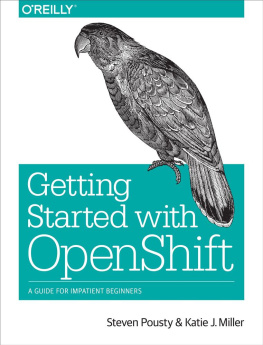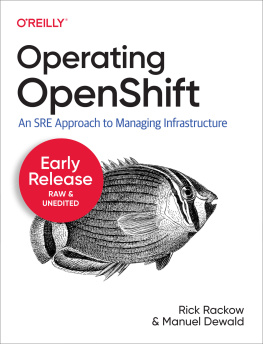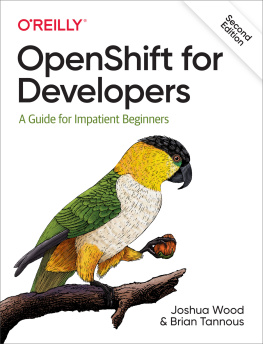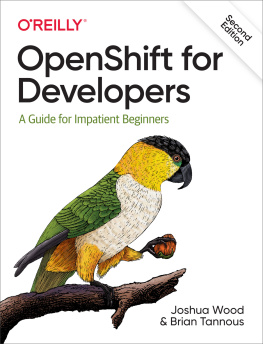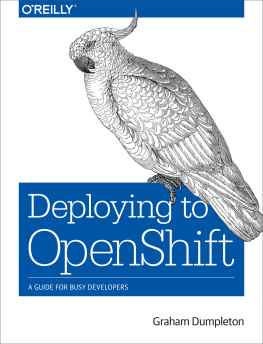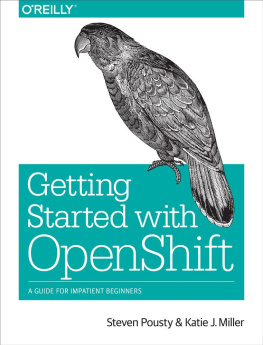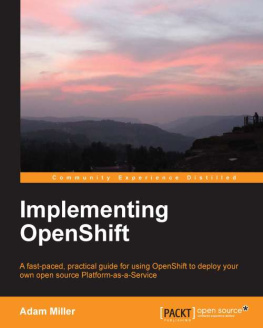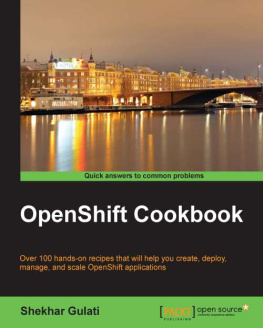Miller Katie J. - Getting started with OpenShift
Here you can read online Miller Katie J. - Getting started with OpenShift full text of the book (entire story) in english for free. Download pdf and epub, get meaning, cover and reviews about this ebook. City: Sebastopol, CA, year: 2014, publisher: OReilly Media, genre: Computer. Description of the work, (preface) as well as reviews are available. Best literature library LitArk.com created for fans of good reading and offers a wide selection of genres:
Romance novel
Science fiction
Adventure
Detective
Science
History
Home and family
Prose
Art
Politics
Computer
Non-fiction
Religion
Business
Children
Humor
Choose a favorite category and find really read worthwhile books. Enjoy immersion in the world of imagination, feel the emotions of the characters or learn something new for yourself, make an fascinating discovery.
- Book:Getting started with OpenShift
- Author:
- Publisher:OReilly Media
- Genre:
- Year:2014
- City:Sebastopol, CA
- Rating:4 / 5
- Favourites:Add to favourites
- Your mark:
- 80
- 1
- 2
- 3
- 4
- 5
Getting started with OpenShift: summary, description and annotation
We offer to read an annotation, description, summary or preface (depends on what the author of the book "Getting started with OpenShift" wrote himself). If you haven't found the necessary information about the book — write in the comments, we will try to find it.
Getting started with OpenShift — read online for free the complete book (whole text) full work
Below is the text of the book, divided by pages. System saving the place of the last page read, allows you to conveniently read the book "Getting started with OpenShift" online for free, without having to search again every time where you left off. Put a bookmark, and you can go to the page where you finished reading at any time.
Font size:
Interval:
Bookmark:
One of the newest and most promising trends in application development and DevOps is the rise of Platform as a Service (PaaS). If you havent heard of it yet, you will learn more in . Trust us for now when we say it promises to greatly simplify application development and system administration work for web applications. It is also one of the few new technologies that actually helps developers and sys admins to get along, allowing each to trust/enable the other and be happy that their needs are being met. This book is focused on giving the application developer a quick yet ample introduction to Red Hats PaaS, OpenShift.
Fundamentally, the reason you want to use OpenShift is because you like writing applications, not administering servers. With just a couple of changes to the way you develop applications, you can spin up your web server and database with one command. You will no longer need to keep a server operating system up-to-date, patch the web servers, maintain the DNS, and do all the other tasks that distract you from writing code. By the end of reading this guide you will be all set to build, deploy, and host your applications on OpenShift.
First and foremost, those who are impatient! You dont want to sit down and read a lengthy Authoritative Guide or a Reference Manual. You want a nice succinct book to get you going on OpenShift as quickly as possible. If you like the platform and can successfully develop an initial application for it, then you will sit down and read more thorough guides. Given this goal, we do not delve very deeply into any particular topic and there are specific topics we leave out, such as how you build custom server plug-ins to run on OpenShift.
You are a web or mobile application developeryou write apps that use HTTP for part or all of their communication with end users. Perhaps you hate doing sys admin work; this is perfect because deploying your application on a Platform as a Service allows you to bypass what we consider drudgery. If you are a system adminstrator and you want to learn more about providing OpenShift as a development platform, have a look at the Administration Guide.
As the title indicates, we are assuming little in the way of background knowledge except:
- You know how to create a web application.
- You know how to use the command line.
- You can program in one of the six main programming languages OpenShift supports.
- You can use a text editor on a console; the most basic is Nano but Vim or Emacs will be OK as well.
We also assume some familiarity with basic Linux commands. If you have not used a Unix-like terminal, we recommend you review .
This guide is intended for programmers who want to get started using OpenShift as quickly as possible, but also want to understand a little bit of what they are doing.
We want to enable you to become self-sufficient in the basic use of OpenShift for creating and hosting your web applications, in as few words as possible. Therefore, we will not go into long explanations of the technologies used in OpenShift or different programming paradigms, but instead will give you links where you can go to read more.
This book grew out of the numerous workshops and talks we have given for developers. Unfortunately, we cannot be in all the places we want to be or talk to all the developers we want to meet. Our hope is for the book to help scale out our ability to teach more people the joy of developing on OpenShift.
In the course of this book we are going to build a very simple but devastatingly effective applicationa Shakespearean insult generator. It will combine two random adjectives and a noun to insult the user of the web page. It can be found online, running on OpenShift. The app will evolve as we go through the book; it will start as a simple Hello World application, and we will add features until finally it will pull the adjectives and nouns out of a database. We will use the applications development as a means of introducing you to the different aspects of creating and maintaining an application on OpenShift.
For the purposes of this book, we wrote the code in Python, at the risk of alienating programmers who use other supported languages. Hear us out while we explain our reasoning on why Python was the best choice. The book needed to be short, so we did not have room to put code samples for all of OpenShifts supported languages in the text itself. Python is one of the top three programming languages used on OpenShift. We believe that Python is a very readable language (if you can get over your fear of indentation), even to those who are not yet familiar with its syntax. We have endeavored to keep the code base simple; developers of all kinds should be able to follow the code examples.
The goal of this book was not to make you a better Python programmer. It does not go into Python best practices, it does not use a lot of the more advanced libraries, and it does not show advanced usage of Python on OpenShift. For example, it is possible to use app.py in your application to specify a web server other than Apache with mod_wsgi . We do not cover those topics here because the application is merely a vehicle to introduce OpenShifts functionality, which is language agnostic. We plan to post ports of the application to other languages on the GitHub site for the book. Please check there or help us by porting yourselfwe love pull requests.
The aim of this book is to get you up and running on OpenShift as quickly as possible. To that end, we dive into the most crucial content first and fill in the finer details as we go along.
defines Platform as a Service and OpenShift, and gives an overview of the basic terms, technologies, and commands you will need to understand for the rest of the book.
, you will know how to create your own OpenShift application with support for a given programming language, database, and/or other technologies.
explain some of the key application management mechanisms and how to connect your application code with your OpenShift database.
delve into details you may need to support your particular applications needs, such as the use of certain ports or persistent storage space, and to maintain your app in the long term.
outlines the platforms support for team development work.
summarizes the book and presents some additional resources for those interested in more detail on OpenShift.
As you read through this book, you can try out what you are learning by signing up for a free account at for more information).
Throughout the text we use the command line to interact with OpenShift, utilizing the Red Hat Cloud (RHC) client tools. This is a fast and convenient way to interact with OpenShift that will be familiar to many developers; however, there are other options for those who prefer a graphical approach. You can find more information about the OpenShift Web Console and read about OpenShift plug-ins for integrated development environments (IDEs)on the OpenShift website.
This book aims to provide the key information a developer needs to get started with OpenShift; we do not show every possible command or option. If you would like more details, please see the documentation and other resources at the OpenShift Developer Center.
If you would like to write your own cartridges for OpenShift, you will want to check out the Cartridge Developers Guide; we do not cover this topic.
Font size:
Interval:
Bookmark:
Similar books «Getting started with OpenShift»
Look at similar books to Getting started with OpenShift. We have selected literature similar in name and meaning in the hope of providing readers with more options to find new, interesting, not yet read works.
Discussion, reviews of the book Getting started with OpenShift and just readers' own opinions. Leave your comments, write what you think about the work, its meaning or the main characters. Specify what exactly you liked and what you didn't like, and why you think so.

